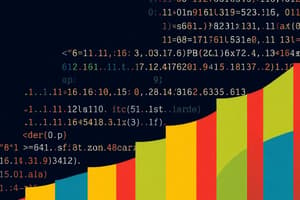Podcast
Questions and Answers
What is the main advantage of using O(n log n) sorting algorithms over O(n^2) algorithms for large datasets?
What is the main advantage of using O(n log n) sorting algorithms over O(n^2) algorithms for large datasets?
- Significantly better performance (correct)
- More readable code
- Lower memory usage
- Easier to implement
What is a primary characteristic of recursive functions?
What is a primary characteristic of recursive functions?
- They are easier to read than non-recursive functions
- They can often simplify complex problems (correct)
- They always consume less memory than iterative functions
- They utilize loops for iteration
When might iterative functions be more appropriate than recursive functions?
When might iterative functions be more appropriate than recursive functions?
- When the problem is simple and straightforward
- When implementing backtracking algorithms
- When recursion causes excessive memory use (correct)
- When speed is not a concern
How can understanding both recursive and iterative techniques benefit problem-solving?
How can understanding both recursive and iterative techniques benefit problem-solving?
Which of the following is a common drawback of recursive functions?
Which of the following is a common drawback of recursive functions?
What is the primary purpose of understanding asymptotic notations?
What is the primary purpose of understanding asymptotic notations?
Which of the following statements about the growth of functions is correct?
Which of the following statements about the growth of functions is correct?
What effect do different growth rates have on an algorithm?
What effect do different growth rates have on an algorithm?
Why is it essential to differentiate between non-recursive and recursive algorithms?
Why is it essential to differentiate between non-recursive and recursive algorithms?
What is one objective of the module on growth of functions?
What is one objective of the module on growth of functions?
Which growth rate is slower than linear growth?
Which growth rate is slower than linear growth?
What does analyzing algorithms with notations primarily involve?
What does analyzing algorithms with notations primarily involve?
How does understanding algorithm behavior as input size increases aid in design?
How does understanding algorithm behavior as input size increases aid in design?
What is the fastest growth rate among commonly encountered complexities?
What is the fastest growth rate among commonly encountered complexities?
What aspect of algorithms is particularly influenced by their growth rates?
What aspect of algorithms is particularly influenced by their growth rates?
Which of the following complexities grows faster than linear growth but slower than polynomial growth?
Which of the following complexities grows faster than linear growth but slower than polynomial growth?
What is the time complexity class that is generally considered impractical for larger inputs?
What is the time complexity class that is generally considered impractical for larger inputs?
In terms of growth rates, which of the following inequalities is true?
In terms of growth rates, which of the following inequalities is true?
Which growth function is represented by a steeply rising curve?
Which growth function is represented by a steeply rising curve?
What is the primary benefit of understanding growth functions and asymptotic notations?
What is the primary benefit of understanding growth functions and asymptotic notations?
What is the effect of higher time complexity on algorithm performance with increasing input sizes?
What is the effect of higher time complexity on algorithm performance with increasing input sizes?
Which of the following online resources focuses specifically on complexity theory?
Which of the following online resources focuses specifically on complexity theory?
Which journal is specifically known for publishing information related to experimental algorithms?
Which journal is specifically known for publishing information related to experimental algorithms?
What is the publication year of the book 'Algorithm Analysis and Design' by Er Deepak Gupta?
What is the publication year of the book 'Algorithm Analysis and Design' by Er Deepak Gupta?
Which resource is known for discussing the NP versus P problem?
Which resource is known for discussing the NP versus P problem?
Which of these references is authored by Sanjay Madhav?
Which of these references is authored by Sanjay Madhav?
Which growth rate is characterized by a constant runtime or space requirement regardless of input size?
Which growth rate is characterized by a constant runtime or space requirement regardless of input size?
What is the growth rate of the binary search algorithm in a sorted array?
What is the growth rate of the binary search algorithm in a sorted array?
Which of the following growth rates is most commonly associated with efficient sorting algorithms like mergesort?
Which of the following growth rates is most commonly associated with efficient sorting algorithms like mergesort?
Which growth rate represents an algorithm where execution time grows proportionally to the square of the input size?
Which growth rate represents an algorithm where execution time grows proportionally to the square of the input size?
Which algorithm exhibits exponential growth, doubling in time with each additional element?
Which algorithm exhibits exponential growth, doubling in time with each additional element?
Which time complexity grows faster than polynomial time but slower than factorial time?
Which time complexity grows faster than polynomial time but slower than factorial time?
What describes the runtime of an algorithm that grows factorially with the size of the input?
What describes the runtime of an algorithm that grows factorially with the size of the input?
Which of the following functions represents linear growth?
Which of the following functions represents linear growth?
Flashcards are hidden until you start studying
Study Notes
Growth of Functions
- Describes how an algorithm's runtime or space needs change with increasing input size.
- Different function types exhibit different growth rates, significantly impacting performance.
- Growth rates predict algorithm behavior as problem size increases.
Common Growth Rates
- Constant Time: O(1): Runtime/space needs don't change with input size. Example: Array element access by index. Graph: Horizontal line.
- Logarithmic Time: O(log n): Function grows logarithmically with input size; slower than linear or polynomial growth. Example: Binary search in a sorted array. Graph: Slowly increasing curve.
- Linear Time: O(n): Function grows linearly with input size. Example: Iterating through an array. Graph: Straight line.
- Linearithmic Time: O(n log n): Function grows proportionally to n log n; common in efficient sorting. Example: Merge sort or quicksort (average case). Graph: Curve faster than linear, slower than quadratic.
- Quadratic Time: O(n2): Function grows proportionally to the square of the input size; typical in algorithms with nested loops. Example: Bubble sort or selection sort. Graph: Parabolic curve.
- Cubic Time: O(n3): Function grows proportionally to the cube of the input size. Example: Some naive matrix multiplication algorithms. Graph: Steeply increasing curve.
- Exponential Time: O(2n): Function doubles with each additional element; very rapid growth. Example: Brute-force Traveling Salesman Problem solution. Graph: Extremely steep curve.
- Factorial Time: O(n!): Function grows factorially; impractical for large inputs. Example: Generating all permutations of n elements. Graph: Very steep curve, steeper than exponential.
Comparing Growth Rates
- Logarithmic growth (O(log n)) is much slower than linear growth (O(n)).
- Quadratic growth (O(n2)) is significantly faster than linear growth.
- Exponential growth (O(2n)) is much faster than polynomial growth.
- Factorial growth (O(n!)) is the fastest among common complexities.
- Relative growth order: 1 < log n < √n < n < n log n < n2 < n3 < 2n < n!
Recursive vs. Iterative Algorithms
- Recursive functions effectively decompose complex problems into smaller subproblems. Understanding recursive algorithm design and analysis is crucial for efficient problem-solving.
- Iterative (non-recursive) functions use loops and explicit state management; a practical alternative to recursion when recursion might cause performance issues or excessive memory use. Choosing between recursive and iterative approaches depends on specific problem needs and constraints.
Asymptotic Notations
- Essential for evaluating and comparing algorithm efficiency.
- Provide insights into how performance scales with increasing input sizes.
- Help in making informed decisions about algorithm design and optimization.
- Aim for lower time complexity for efficient handling of large inputs. For example, O(n log n) algorithms are preferable to O(n2) algorithms for large datasets.
References
- The module lists several printed and online resources for further study on algorithms and complexities. These include textbooks, journals, and online resources.
Studying That Suits You
Use AI to generate personalized quizzes and flashcards to suit your learning preferences.




